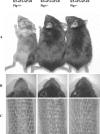Plasminogen mediates the pathological effects of urokinase-type plasminogen activator overexpression
- PMID: 15161662
- PMCID: PMC1615761
- DOI: 10.1016/S0002-9440(10)63786-8
Plasminogen mediates the pathological effects of urokinase-type plasminogen activator overexpression
Abstract
Increased expression of urokinase-type plasminogen activator (uPA) and its receptor (uPAR) is associated with different pathological conditions. Both uPAR-mediated signaling and plasmin-catalyzed extracellular proteolysis may contribute to pathogenesis. To evaluate the involvement of plasminogen in such circumstances, we have taken advantage of transgenic mouse models in which overexpression of uPA and/or uPAR in enamel epithelium, basal epidermis, and hair follicles leads to a pathological phenotype; uPA transgenic mice have chalky-white incisors and, when uPAR is co-expressed, develop extensive alopecia, epidermal thickening, and subepidermal blisters. We report here that when these transgenic mice were backcrossed into a plasminogen-deficient (Plg-/-) background, the dental and skin phenotypes appeared completely normal. Heterozygous Plg+/- transgenic mice exhibited a haplo-insufficiency, with an intermediate or normal phenotype. These results do not argue in favor of a role for uPAR-mediated signaling in our experimental model; rather, they demonstrate an essential, dose-dependent, requirement for plasminogen in uPA-mediated tissue alterations. They also support the hypothesis that plasminogen could play a part in certain skin diseases.
Figures





References
-
- Ellis V, Scully MF, Kakkar VV. Plasminogen activation initiated by single-chain urokinase-type plasminogen activator: potentiation by U937 monocytes. J Biol Chem. 1989;264:2185–2188. - PubMed
-
- Ellis V, Behrendt N, Dano K. Plasminogen activation by receptor-bound urokinase: a kinetic study with both cell-associated and isolated receptor. J Biol Chem. 1991;266:12752–12758. - PubMed
Publication types
MeSH terms
Substances
LinkOut - more resources
Full Text Sources
Molecular Biology Databases
Miscellaneous

